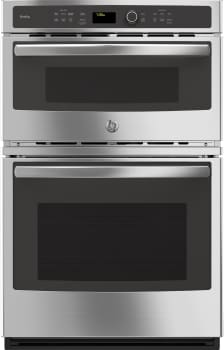GE PK7800SKSS 27 Inch Combination Electric Wall Oven with 6 Total cu. ft. Capacity
Enhance your kitchen with this combination wall oven by GE. The microwave oven features 1.7 cu. ft. of capacity and convection which circulates heat for high-quality results. The lower oven provides 4.3 cu. ft. of capacity, true European convection, and an array of cooking options.
27 Inch Combination Electric Wall Oven with 6 Total cu. ft. Capacity, True European Convection Oven, Convection Microwave, Proof, Defrost, Warm, Delay Start, Ten-Pass Bake Element, Steam Clean, and GE Fits! Guarantee: Stainless Steel
Enhance your kitchen with this combination wall oven by GE. The microwave oven features 1.7 cu. ft. of capacity and convection which circulates heat for high-quality results. The lower oven provides 4.3 cu. ft. of capacity, true European convection, and an array of cooking options. The lower oven features an eight-pass broil element that allows you to get full broil coverage and even browning from edge to edge. Utilize the lower oven’s ten-pass bake element to ensure even baking with heat that covers more surface area. The glass touch controls let you set temperatures quickly and clean with little effort. You’ll easily be able to make an array of dishes at once with this double wall oven.
Thanks to GE’s FIT Guarantee, modernizing your kitchen just got easier. GE wall ovens are guaranteed for an exact fit to make replacement easy. Refer to the Fit Guarantee document for full details.
True European Convection Oven
- Achieve delicious results from a third heating element and fan combination.
Convection Microwave
- Circulates heat for high-quality results.
Ten-Pass Bake Element
- Even baking is assured with heat that covers more surface area.
Eight-Pass Broil Element
- Get full broil coverage and even browning from edge to edge.
Defrost
- Safely and efficiently defrost your food
Warm
- Keep food warm until everyone is ready to eat.
Steam Clean
- Clean your oven the way you want.
Glass Touch Controls
- Set temperatures quickly and clean with little effort.
GE Fits! Guarantee
- GE wall ovens are guaranteed for an exact fit to make replacement easy.
Additional information
| Total Capacity | 6 cu. ft. |
|---|---|
| Upper Oven | 1.7 cu. ft. |
| Lower Oven | 4.3 cu. ft. |
| Amps | 30A |
| Volts | 240/208V |
| External Width | 26 3/4" |
| External Depth | 26 7/8" |
| External Height | 42 3/8" |
| Cutout Width | 25" |
| Cutout Depth | 23 1/2" |
| Cutout Height | 41 1/8" |






by Sharon
Just simply a touch is all you need to make this wonderful Microwave, Convection Oven do it’s magic. My Golden years are made simple
by Maryland
I love all the oven rack positions and slide out rack. Control panel is easy to use. We Love it?
by Mar
Excellent oven & microwave cooks everything great!!!